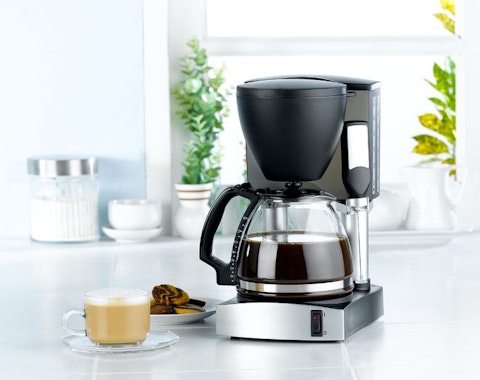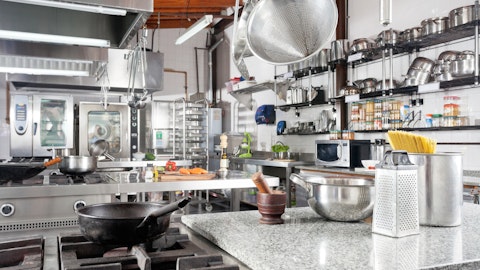Williams-Sonoma, Inc. (NYSE:WSM) Q2 2023 Earnings Call Transcript August 23, 2023
Williams-Sonoma, Inc. beats earnings expectations. Reported EPS is $3.12, expectations were $2.72.
Operator: Welcome to the Williams-Sonoma, Inc. Second Quarter 2023 Earnings Conference Call. At this time, all participants are in listen-only mode. A question-and-answer session will follow the conclusion of the prepared remarks. I would now like to turn the call over to Jeremy Brooks, Chief Accounting Officer and Head of Investor Relations. Please go ahead.
Jeremy Brooks: Good morning and thank you for joining our second quarter earnings call. I’d like to remind you that during this call, we will make forward-looking statements with respect to future events and financial performance, including guidance for fiscal ‘23 and our long-term outlook. We believe these statements reflect our best estimates. However, we cannot make any assurances these statements will materialize, and actual results may differ significantly from our expectations. The Company undertakes no obligation to publicly update or revise any of these statements to reflect events or circumstances that may arise after today’s call. Additionally, we will refer to certain non-GAAP financial measures. These measures should not be considered replacements for and should be read together with our GAAP results.
A detailed reconciliation of non-GAAP measures to the most directly comparable GAAP measure appears in Exhibit 1 to the press release we issued earlier this morning. This call should also be considered in conjunction with our filings with the SEC. Finally, a replay of this call will be available on our Investor Relations website. Now I’d like to turn the call over to Laura Alber, our President and Chief Executive Officer.
Laura Alber: Thank you, Jeremy. Good morning, everyone, and thank you for joining the call. Before we get into the details of the quarter, I’d like to take a moment to thank the incredible team at Williams-Sonoma, Inc. Without their outstanding work, creativity and relentless focus, none of the results we’re reporting today would be possible. We are pleased to deliver another quarter of strong earnings. We significantly exceeded profitability estimates with an operating margin of 14.6%, with earnings per share of $3.12 well above our pre-pandemic results. Our sales ran negative 11.9% in Q2, but our two-year comp was essentially flat, and our four-year comp to 2019 was positive 39.7%. We achieved these results against an increasingly promotional environment and softening industry metrics by leveraging our market advantages and focusing on regular price selling, driving improved customer service, and controlling costs.
We are in a period where consumers are buying fewer large-ticket furniture pieces than they did a year ago, as they shift their spending. However, our advantage is our portfolio of brands serving a range of categories, aesthetics and life stages. Only approximately half of our business is furniture, and we are seeing relative strength in kitchen purchases, fashion textiles, dorm, baby and seasonal holidays and our in-house design capabilities and vertically integrated sourcing organization allows us to design and develop quality products at a great value, but we are not only innovators, we are also operators. Core to our business model is a digital-first, but not digital-only channel strategy that supports our world-class shopping experience.
We are pleased that due to our focus and investments in operations, we have made meaningful progress on our customer service. We have seen improvements in our key metrics, including on-time delivery and damages, both of which improve customer satisfaction and reduce costs. On the digital front, we continue to control ad costs tightly, optimizing spend with a focus on the most productive channels, leaving some flexibility to test into formats that tap into new audiences. And as one of the largest e-commerce players, we continue to enhance our proprietary e-commerce tech stack. We believe we will lead the way in retail and our use of AI in our tech capabilities, including our homegrown recommendations engine used for enabling relevant product selection on our website, and our AI-powered room design tool with intelligent design guidance.
We also operate a best-in-class retail business with our stores not only serving as billboards for our brands, but driving profit and customer service. I truly believe we have the best team in retail, and our stores are beautifully designed and curated with aspirational assortments, and our continued retail optimization efforts have refocused our fleet on the most profitable, inspiring, and strategic locations. Additionally, we continue to enhance our Omni initiative to better serve our customers and drive profitability. We also tightly manage all the other expenses, including employment costs. In both Q1 and Q2, we made tough decisions to right-size our organization to control costs and drive efficiency, and we’ve closely managed our inventory levels to align with our demand trends while improving our in-stocks.
Total inventory was down 15.7% versus last year. Now I’d like to tell you about our progress and our sustainability efforts. In Q2, we released our 2022 impact report, highlighting our commitment to our values and our progress toward achieving our science-based targets and other sustainability goals. As you’ll recall in our report, we significantly scaled renewable energy, and in our value chain, we launched a vendor engagement and preferred material strategy to reduce emissions. We also detailed progress in our worker well-being goals. Our commitment to fair trade premiums, NEST-certified ethically handcrafted products, and other programs that impact the lives of almost 100,000 individuals globally. We are committed to action and continuous improvement, and we are making meaningful progress on the path we’ve laid out.
Also, we launched a new home furnishings brand, GreenRow, which I’ll discuss later, which uses sustainable materials and manufacturing processes and targets in emerging demographic that prioritizes sustainability and the brands they support. Now I’d like to spend a few minutes talking about our brand. Barn [ph] ran a negative 10.6% comp in Q2, but a 10.9% 1.6% comp in Q2, but a 10.9% positive on a two-year and a 48.7% positive on a four-year basis. Although furniture demand has decelerated, we are seeing relative strength in easy updates in decorating, frames, pillows, throws and table linens. In late July, we launched our new and seasonal fall assortments, and we’re getting a strong response to our proprietary textiles, including duvets, quilts, pillows and rugs.
Halloween decorating is off to a strong start, which is a good indicator for the upcoming holiday season. In furniture, we’re seeing strength in our new lighter finishes, velvets and cozy fabrications and while it is early, the new fall assortment is up versus new fall last year. Also in Q2, we successfully opened our newly relocated store on Post Road in Westport, Connecticut, with much success. Repositioned stores like this are proving to be very productive as they bring to life our broader product assortments and showcase our free design services. Westport is an example of the effectiveness of our company-wide retail optimization strategy, which includes closing smaller and older stores and repositioning it to larger stores in open air lifestyle centers and destination street locations.
The Pottery Barn Children’s business ran a negative nine comp in Q2 and was negative 3.8% on a two-year basis and positive 19.1% on a four-year basis. Across these life-stage brands, we are focused on delivering compelling innovation and elevating the customer experience. One key area in the quarter has been our back-to-school offering. We’re proud to expand our market-leading gear to include an accessible option and to build upon our best-selling desk with accessible study solutions. Another highlight is our dorm assortment, which addresses the distinct needs of college-bound students with XL twin bedding, no-nails decor, and storage. The dorm opportunity is significant given the underserved market, and we expect to continue to pick up market share and drive year-over-year double-digit growth in this category.
Customers can shop online and ship product to any of our company stores that are closest to their college campus. Included in our dorm offer, we are excited to showcase our partnership with LoveShackFancy, which has gained even more traction with the dorm launch. We also continue to focus on Baby, the entry point to our Pottery Barn Kids brand. Here we are winning with our Green Greenguard Gold Nursing Seating, our curated selection of baby gear, and the expansion of furniture and gifts in our stores. Now let’s talk about West Elm. West Elm is the brand that has been most impacted by the customer pullback in furniture. In Q2, West Elm ran a negative 20.8% and was negative 14.7% on a two-year basis, but ran a 43.4% positive on a four-year basis.
West Elm is our brand with the highest percentage of its assortment in furniture, the most underdeveloped in other categories, and a customer base that has been most impacted by the environment. Despite current challenging dynamics, the brand made progress on two key areas that we believe will drive improvement in their business in the near term. First, newness. We are doubling our newness penetration in the back half, fuelled by our fall and holiday launches. We are encouraged by the strong performance of the new fall product launch so far, which marks a real evolution in the brand’s modern design voice. And while it is a small assortment, it is exceeding the performance of last year’s fall newness. And second, given the success of recent collaborations with Colin King Studio and Rode and the response to fall products, we see sizable opportunity in West Elm as it expands into textile, decorative accessories, entertainment, and seasonal offerings.
These two key focus areas underpin the opportunity to improve customer counts and omni-channel performance in the brand, and we continue to be very optimistic about the long-term growth trajectory of West Elm with its industry-leading design and value. The Williams-Sonoma brand ran a negative 0.7% comp in Q2. On a two-year basis, the brand was essentially flat and positive 35.7% on a four-year basis. The quarter was driven by our kitchen business, which ran positive comps, offset by the home business. Throughout Q2, high-end electrics, particularly in coffee and espresso, continued to lead the way in growth with successful new product launches. Customers also responded well to categories like storage and organization with our exclusive Hold Everything collection.
And for the balance of the year, we have a strong pipeline of exciting, exclusive product launches and strong collaborations. And based on early resale on Halloween and Autumnal, we expect the holiday entertaining and dining-at-home businesses will drive strong results for the brand. Now I’d like to update you on our other key initiatives. Business-to-business ran down 5% in Q2. We continue to see strength in our contract business, which ran positive 23% in the quarter, sequentially improving from Q1. We won several proposals across industry segments, including with Sony and the entertainment space, the San Antonio Spurs training facility, and multiple properties with The Montaje, The Four Seasons, Weston, Hilton and Hyatt. The trade business has been more impacted by the slowed housing market.
However, we see recent improvement in our trend, and we remain confident on this piece of the B2B business long-term. Now I’d like to talk about our global business. A standout performer this quarter is our Canadian business. We continue to see strength from our recently replatformed e-commerce website, and we are excited with the launch of our Wedding Registry service in August in Canada. The Mexico market continues to show strength due to strong execution of design services and an improved in-stock position. India also remains a key growth market in our global business, with strong year-over-year performance and the opening of three new stores next month, including the first Potter Barn Kids store. Lastly, I’d like to update you on our emerging brands.

Copyright: johnkasawa / 123RF Stock Photo
At Rejuvenation, we continue to see success from the replatforming of the website with improved sales, conversion, and customer experience. The brand is seeing outperformance in its home project categories and strength in newly entered growth categories. At Mark & Graham, our high-quality gift and personalization brand, the business drove a high single-digit comp in Q2. And at GreenRow, we are pleased with the initial reaction to the new brand and the assortment and while it’s early and the volume is small, we are ahead of plan and remain optimistic about the potential of this brand and it’s aesthetic. These successful and exciting emerging brands are a testament to our ability to develop new businesses that expand our portfolio of brands and address white space in our product offering, all with minimal investment, low cost of entry, and leveraging our knowledge and infrastructure.
In summary, we recognize there’s been a pullback in spending on high-ticket discretionary goods with relative strength in certain other categories. Despite this top-line pressure, the proven strength of our operating model produced strong earnings this quarter, driven by our focus on service, cost control and regular price selling. As we put this all together, we have changed our outlook for the year. We now expect full-year revenues to come in at a range of down 5% to down 10%, and we are raising our outlook on operating margin to a range of 15% to 16%. It is important to note that the reduction in our revenues outlook is offset by our raised operating margin outlook. On balance, we believe that running our business with tighter inventory, stronger merchandising and design curation with fewer promotions will continue to drive customer satisfaction and long-term growth.
Thank you, and now I will turn the call over to Jeff Howey.
Jeff Howie: Thank you, Laura, and good morning, everyone. As Laura said, we are proud that once again we have delivered a strong quarter of earnings. Our Q2 results reflect the themes we have been communicating over the past several quarters. First, our steadfast commitment to maintain price integrity and not run site-wide promotions, even if it means forgoing some revenues in the short term. Second, our first-half supply chain cost headwinds that will become second-half tailwinds. Third, our ability to control SG&A costs and manage inventory levels and finally, how we have structurally changed our operating model, driven by a higher e-commerce mix and our retail optimization strategy. Our earnings this quarter exceeded expectations, despite softer top-line revenues.
This illustrates the profitability of our platform and supports our 15% operating margin floor. Now let’s dive into our Q2 results, followed by an update on our fiscal year guidance. As I did last quarter, in addition to year-over-year results, I’ll reference 2019, as it’s helpful to compare our performance with pre-pandemic levels. Net revenues came in at $1.863 billion. While below our expectations, our revenues reflect a larger home furnishings backdrop and our commitment to maintain price integrity as the industry became more promotional. Our revenue growth in Q2 came in at negative 11.9% comp. Our two-year stack was essentially flat, and our four-year stack against 2019 grew 39.7 percent. Our Q2 demand at negative 11.4% was materially in line with our revenue comps, reflecting a normalized spread between demand and net comps, as I mentioned last quarter.
On a two-year stack, our demand was negative 8.1%, and on a four-year stack, our demand was a positive 37.4%. From a cadence perspective, our demand trends continued to be inconsistent and choppy and decelerated from Q1, driven by a pullback in consumer spending and high ticket discretionary. Moving down the income statement, gross margin at 40.7% was in line with our expectations. While 280 basis points below last year, our gross margin sequentially improved over Q1 by 210 basis points. Merchandise margins decreased year-over-year as the residual amount of the capitalized costs from higher product costs, post-infreight, detention and demerge fitting on our balance sheet flowed into our income statement. Excluding these atypical capitalized costs, our merchandise margins were in line with last year.
Selling margin also continued to be impacted by higher outbound customer shipping costs, although to a lesser extent than prior quarters. We incurred these higher costs to best serve our customers by shipping from out-of-market distribution centers and, in some cases, intentionally shipping multiple times for multi-unit orders, which typically would have been fulfilled in a single shipment. While we still have room to elevate our customer experience, we made substantial progress in Q2 with our customer service. I’d like to congratulate and thank our supply chain organization for elevating our service experience. Altogether, our selling margins were 90 basis points lower than last year. Driven by these short-term supply chain costs and inefficiencies, we’ve been discussing the past several quarters.
As these costs are now fully amortized, Q2 will be the last quarter we report on these headwinds. In fact, we anticipate they will become tailwinds over the next few quarters. Occupancy costs, at 10.9% of net revenues, were 190 basis points above last year. Occupancy dollars, at $203 million, grew 5.3% over last year and were essentially flat quarter over quarter. Our 200 basis points leverage versus 2019’s 12.9% occupancy rate demonstrates the impact our higher e-commerce mix and our retail optimization strategy have had on our gross margin, despite Q2 ’23’s softer top-line results. Our Q2 gross margin, at 40.7%, remained 530 basis points higher than 2019’s 35.4%. And that includes absorbing the residual 90 basis points in supply chain-related costs and inefficiencies.
Our SG&A rate once again reflects our ability to control costs in a challenging environment, with Q2 coming in at 26.1%, leveraging 30 basis points to last year. We leveraged both employment and ad costs in the quarter. Employment leveraged as we managed variable employment costs in accordance with our top-line trends. We also benefited from reduction in force actions in Q1 and Q2, as we continue to look for opportunities to improve efficiency, remove redundancy and streamline operations. Our advertising leverage reflects the competitive advantage of our agile, performance-driven marketing organization. Our in-house capabilities, first-party data, and multi-brand platform allow us to drive efficient advertising spend as we see business trends evolve.
Overall, SG&A came in 240 basis points lower than 2019’s SG&A rate of 28.5%. Once again, these results highlight the impact our higher-econ mix and our retail optimization strategy have on our profitability. With regard to the bottom line, we are pleased with our results, especially in light of the quarter’s challenging industry environment. Q2 operating income came in at $272 million, and operating margin at 14.6%. While down 250 basis points below last year, 14.6% stands 770 basis points above 2019’s 6.9%. These results reflect the power of our profitability initiatives and underpin our 15% operating margin long-term guidance. Our diluted earnings per share of $3.12 was 75 cents, or 19% below last year’s record second quarter earnings per share of $3.87, but significantly above 2019’s earnings per share of only $0.87.
On the balance sheet, we ended the quarter with a cash balance of $514 million with no debt outstanding. This was after investing $43 million in capital expenditures supporting our long-term growth and returning over $69 million to our shareholders through quarterly dividends and share repurchases. Merchandise inventories, at $1.3 billion, were down 15.7% to last year. Three important points I’d like to emphasize here. First, we are well positioned to maintain our price integrity as we proactively manage our inventory levels in line with our demand trends. Second, our in-stock levels are robust and near historical highs and our regional balance and composition has improved considerably. And finally, third, our Q2 ending inventory levels are up only 9.5% versus same period in 2019, and that’s with revenue comps of 40% over the same time frame.
This highlights how we’ve improved our efficiency and turnover. Summing up our Q2 results, we’re pleased to have delivered earnings exceeding expectations. I want to pause and thank all our associates across our stores, supply chain, customer service centers, global operations, and corporate offices for delivering these results in a challenging environment. Now let’s turn to our outlook. We are updating our fiscal ’23 guidance to reflect both the ongoing top-line uncertainty and the proven strength in our operating margins. We now expect full year ’23 net revenues to be in a range of down 5 comp to down 10 comp, and we are increasing our operating margin outlook to a range of 15% to 16%. It’s important to note that our lower sales outlook is offset by a raised operating margin, producing materially similar implied EPS guidance.
On the top line, our updated guidance is based upon the facts and trends we know today by extrapolating our one, two and four-year trends in Q2 to full year ’23 net revenues. Specifically, our Q2 one-year trend yields full year revenues at the low end of guidance, while our Q2 two-year trend yields full year revenues at the midpoint of guidance. And our Q2 four-year trend yields four-year revenues at the high end of guidance. While our top-line year-over-year comparison gets easier in the back half, we recognize the challenging environment for home furnishings. On the bottom line, when aligned with historical quarter-over-quarter bills, our strong Q2 operating margin produces full year operating margin within our updated range of 15% to 16%.
Additionally, in the back half of the year, our headwinds from the short-term supply chain costs will become tailwinds that support our operating margin guidance. We also expect our full-year income tax rate to be approximately 26%. Our 2023 capital allocation plan remains unchanged. We will continue to prioritize funding our business operations. Commensurate with our industry-leading return on invested capital, we will also invest $250 million in capital expenditures in high-return projects to support our long-term growth. As we’ve communicated quarterly, we are committed to returning excess cash to shareholders through dividends and opportunistic stock repurchases. We will continue to pay our quarterly dividend of $0.90 per share, and we have almost $700 million remaining under our current $1 billion share repurchase authorization to repurchase our stock opportunistically.
As we look further into the future, we are reiterating our long-term guidance of mid to high single digit top-line growth with operating margins exceeding 15%. We’re confident we’ll continue to outperform our peers and deliver profitable growth for these reasons, our ability to gain market share in the fractured home furnishings industry, the strength of our in-house proprietary design, the competitive advantage of our digital-first but not digital-only channel strategy, the ongoing strength of our growth initiatives, and the resilience of our fortress balance sheet. With that, I’ll open the call for questions.
See also 12 Most Undervalued Blue Chip Stocks to Buy According to Hedge Funds and 15 Countries That Tip the Most in 2023.
Q&A Session
Follow Williams Sonoma Inc (NYSE:WSM)
Follow Williams Sonoma Inc (NYSE:WSM)
Operator: [Operator instructions] Our first question comes from Max Rakhlenko from TD Cowen. Please go ahead. Your line is open.
Max Rakhlenko: Great. Thanks a lot and congrats on the nice results. So, as we think about your margin profile and the long-term outlook, what do you view as structural differences today compared to pre-pandemic versus ones that have been a little bit more temporary in nature and could still potentially have risk ahead?
Jeff Howie: Good morning, Max. That’s a great question. I think it all goes back to what I’ve been talking about over the past few quarters regarding our 15% operating margin floor. The structural changes in the business start with our higher e-commerce sales mix, where we continue to drive growth in a higher contribution channel, and our retail optimization strategy, where we’ve really repositioned our fleet to be more profitable and more productive. It also comes down to those structural changes that, in and of themselves, bridge us to a lot of our margin results we’re seeing today in second quarter and in our guidance. Additionally, we have the supply chain efficiency that’s coming. We’ve been talking for the past few quarters about the headwinds and the short-term supply chain costs that we’re seeing on our balance sheet and how they float through our income statement.
Those are now behind us, and these headwinds are going to become tailwinds in the back half of 2023 and into 2024. We also have the pricing power that I think we demonstrated in Q2, where our in-house design and our proprietary products command a higher price point in the market and with the strength of our design teams and our global sourcing organization, we’re able to provide the consumer with a very competitive value equation for them to consider. We’ve also demonstrated our ad cost optimization and how our in-house capabilities, with our own hands on the keyboard, really make a difference in our ability to control those costs and leverage them with sales. And then finally, I’d say our cost inventory reductions, which we demonstrated the past few quarters, we’ve managed our SG&A very efficiently and as you can see, this quarter, with our inventory down 16%, we’re very good at managing our inventory levels over time.
Here’s the key point. Our operating margin is sustainable and could even go higher from here with more leverage from higher revenues.
Operator: Our next question comes from Seth Basham from Wedbush Securities. Please go ahead. Your line is open.
Seth Basham: Thanks a lot and good morning. Could you help us dimensionalize the difference in performance in your business between furniture and non-furniture categories? How much stronger were non-furniture categories, or how much of a decline did you see year-over-year in furniture-related growth?
Laura Alber: Sure. Hi, it’s Laura. We are so fortunate to have a portfolio of brands serving life stages, different aesthetics, and different parts of the house, for that matter and while we do have a large portion of our business in furniture, we also have business in textiles, decorating, entertaining. We have quite a robust children’s business. Baby is the entry point, dorm and these are all very different businesses and so while we did see a generalized pullback across many categories, there are some real winners and these winners are not just happenstance. It is because we have been working so hard to build these businesses. We talked about our growth drivers and there is both growth in new brands and new ways to sell to customers like B2B, but there is also growth in categories where the market is underserving the customer and one of those is dorm and the dorm business is a very large fraction market and with the exit of Bed Bath & Beyond and others struggling, we picked up I believe pretty considerable market share very quickly and we’ve been working both on the product assortment side of that equation, but also on logistics and there is still a lot of room to grow from here because we are still relatively small.




